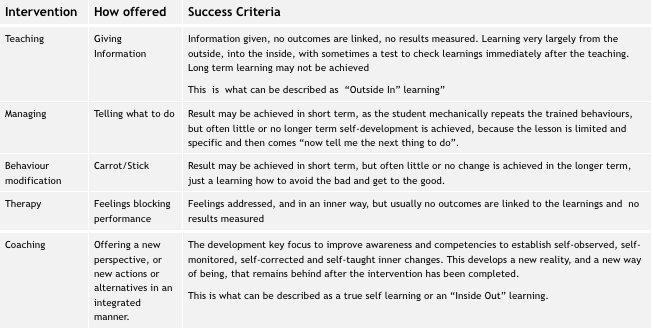 |
How do you learn? – “To Know and Not Do, is Not to Learn”
Learning and how do you learn best could be an odd subject to consider, but at this level of development I feel it is a very important one;
“Learning is the change/s a person makes in him/herself that increases the know-how, know-what and/or the know-why the person possesses in respect to a given subject” (Vaill 1996:21, after Carroll and Gilbert 2005/2011)
Ask yourself some questions about how you learn and what helps you learn:
What has been the most significant shift in your embedded knowledge (learning) in the last few years?
What was it that enabled this shift? your attitude?,
motivation? The other people involved?
What did you or the people involved do to make this shift happen?
What (or who) has blocked your learning in the past?
Where do you think your next big learning will occur, over what aspect of you or your life and why would this be significant
Keep these observations to discuss with your coach or coach supervisor at your first session, and to review it periodically.
I have been through a lot of formal education and quite a lot of less formal training and skills development. Ultimately all learning is self-learning, because if we don’t absorb it into ourselves and change our actions, behaviours, beliefs or whatever, if we do not use the learning then we have not learnt.
Here are various modalities that are used to learn, where other people are involved, and it may help you differentiate

From the table, maybe you can see how much of our formal learning is led by a person who does not change their style. Maybe you had a good teacher at school, where knowledge flowed into you effortlessly, and maybe you had the opposite too, where you did not connect with the teacher or the topic or the details. This is typical of “Outside in” learning, where the information is presented, and you must figure out how to get it inside and act upon it.
As we get into deeper layers of learning and especially in coaching and coach supervision where the learning can be transformational, then the client, the coach and the coach supervisor has a responsibility to consider how best to “land” the learnings that have arisen for the client or coach. Being flexible and adaptable to facilitate this deep core learning. This is about joining the client or coach in their world (their structure of interpretation, SOI) being flexible enough to “lean” into their world. The Centre for Coaching trainings (UCT) then uses “Distinctions” to help a client visualise a new way of being, a new way of acting. These are also called “Metaphors” in other schools, while maybe the Bible called them parables. This “Inside out” learning is what sticks and transforms people into the future, allowing for an improvement in their own competencies to establish self-observed, self-monitored, self-corrected and self-taught inner changes.
One other useful tool to consider with learning, especially when it is deep or difficult, is to do an “After session review”;
What did we set out to do?
What happened?
What went well?
What went badly?
What have we learned?
What will we do differently?
Keep these observations to discuss with your coach or coach supervisor at the next session.
|















